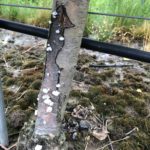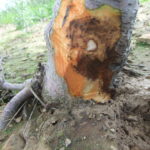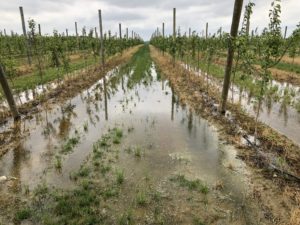Current wet weather is increasing the risk of Phytophthora diseases in the orchard. Phytophthora is a major problem on apples and pear; stone fruit are also susceptible, with plums being the most resistant to this disease. In addition to excessive soil moisture and flooding, moderate temperatures, wounds (mechanical or through herbicide damage), and rootstock susceptibility all factor into Phytophthora infection.
Early spring symptoms of this disease include delayed bud break, smaller than normal and/or discolored leaves, along with twig or small branch dieback. Trees often look ‘unthrifty’ and sparse (Fig. 1). Unfortunately, these symptoms can be mistaken for nutrient deficiency, winter injury, or even herbicide (Fig. 2) or flood damage. It can also resemble fire blight infection of the rootstock. Examination of the crown is an essential aspect of diagnosing this problem. Peeling away the bark may reveal discoloration, cankering or rotting at or below the graft union, with healthy green tissue distinct from diseased tissue that is orange to brown in color (Fig. 3). Cankers may be weeping or gumming. Later in the season, if weather turns dry, trees will ‘collapse’ and suddenly fail if the stem is completely girdled and can no longer supply the leaves with sufficient water or the roots with sufficient nutrients.
- Fig. 1. The sparse, unthrifty appearance of Phytophthora infected trees. Photo by Janna Beckerman.
- Fig. 2. Herbicide injury creates infection courts for opportunistic pathogens like Phytophthora, or Schizophyllum commune, shown here. Photo by Janna Beckerman
- Fig. 3. Orange to brown discoloration of the dying rootstock. Photo by Mike Ellis.
Root rot is the most difficult aspect to diagnose of this disease. Root examination is often tricky. Look for soft, brown, punky roots, if the infection is widespread (or you are extremely lucky in selecting your sampling site!). Trees that have root rot but not crown infections often present with unthrifty growth, small leaves and even a heavy fruit set. Just like a girdling canker, root rot infections can result in tree ‘collapse’ when compromised roots can no longer supply the tree with sufficient water should weather turn dry.
Unfortunately, unhealthy stems lead to unhealthy roots, and vice a versa, so a conclusive laboratory assessment is essential in the diagnosis of Phytophthora crown and root rot, and to rule out fire blight. Keep in mind that most rootstock infections of fire blight occur in orchards with a history of fire blight.
Disease Cycle:
The disease is caused by members of the genus Phytophthora, including but not limited to P. cactorum, P. cambivora, P. citricola, and P. plurivora, all of which are found in Indiana. Although not a true fungus (and more correctly called a chromista, oomycete, or stramenopila), and commonly called a ‘water mold’, it thrives in excess moisture and cool temperatures for infection and reproduction. Infection occurs most commonly in spring and fall, but can happen whenever excess soil moisture and favorable temperatures coexist. Phytophthora species can produce three different types of spores (mobile zoospores that swim; oospores, and chlamydospores) all of which can infect the roots, the crown and the collar of the tree. Infection can even splash or spread to the scion, if the scion is susceptible.
Management:
Rootstocks are the best way to manage this disease, and avoiding those rootstocks that are highly susceptible. Different species of Phytophthora vary in their pathogenicity (ability to infect) and all Phytophthora vary in the virulence (how aggressive they are after infection), making the evaluation of rootstocks and the management of this disease challenging.
| Rootstock | Susceptibility |
| G.16 | tolerant2 |
| G.41 | tolerant2 |
| G.935 | tolerant2 |
| G.202 | tolerant2 |
| B.9 | MR |
| G.11 | tolerant2 |
| M7 | MS1 |
| M9 | LS-MS1 |
| M 26 | MS1 |
| MM 104 | MS1 |
| MM 106 | HS1 |
| MM 111 | MS1 |
Tolerant; MR = Moderate Resistance, LS = Low Susceptibility, MS = Moderate Susceptibility, HS = High Susceptibility.
Avoid planting in low spots and minimize ruts to reduce puddling, when possible, or fill in promptly. The disease is most common in low-lying areas, particularly when the soils are heavy clay, and poorly drained. Excessive rain, and even ruts, can serve as focal points for Phytophthora to collect (Fig. 4).
Fungicides Drenches:
- Mefenoxam (RidomilGoldSL) at 2 quarts/acre in sufficient water to move it into the root zone. Will slow cankering with continued treatment but will not rescue trees with more than 50% of the stem girdled. FRAC CODE 4 fungicide. 48-hr reentry.
- Metalaxyl (MetaStar2E) at 2 gal/acre or 6 fl oz/1000 sq ft. Treat the entire root zone as a banded application FRAC CODE 4 fungicide. 48-hr reentry.Foliar sprays:
Unlike most fungicides, the mono-and di-potassium salt fungicides are amphimobile, meaning application to leaves will redistribute to the roots. - Phosphorus acid, Mono-and di-potassium salts (Agri-Fos, Alude, etc.). Do not apply if copper fungicides have been used for the management of other diseases. FRAC Code 33 fungicide.
- Fosetyl AL (Aliette WDG) for bearing and non-bearing apples. For cherry non-bearing trees only. Do not use with copper. FRAC Code 33 fungicide.1. Carisse, O., and S. Khanizadeh. 2005. “Relative resistance of newly released apple rootstocks to Phytophthora cactorum.” Canadian Journal of Plant Science no. 86:199-204.2. GENEVA APPLE 2. ROOTSTOCKS COMPARISON CHART v.2 online at: https://www.canr.msu.edu/uploads/236/100348/GENEVA-Apple-Rootstocks-Comparison-Chart.pdf



